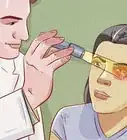This article was co-authored by Shara Strand. Shara Strand is a Makeup Artist and the Founder of Shara Makeup Studio, a makeup and image consulting studio based in New York City. She has over 15 years of image and makeup consulting experience including working as a regional artist for Bare Escentuals and Estee Lauder, Saks 5th Avenue, Bloomingdales, and Bergdorf Goodman. Her work has been featured in WNBC, Fox 5, Direct TV ABC morning news, and Hamptons Magazine. She is the creator of Shara Cosmetics and is a two time Billboard charted singer. She holds a BFA from New York University.
There are 10 references cited in this article, which can be found at the bottom of the page.
This article has been viewed 71,658 times.
If after applying your eyeshadow, you realize the colors look dull, don't worry! You can easily make your eyeshadow look more prominent and pigmented. First, apply eyelid primer to all of your eye. Then, use a white base to make your eyes pop. Finally, apply a cream eyeshadow and then build layers using powdered eyeshadow. In addition, you can use a little water to make your powdered eyeshadow to make your pigment more bold.
Steps
Priming Your Eye
-
1Use eyelid primer for best results. Applying eyeshadow primer before you apply other makeup is the best way to make your shadow look more pigmented. Squeeze a dime-size amount of primer onto your eyelid. Then, rub in the primer using your index and middle finger.[1]
- Dab the primer at the lash line, then slowly work up to your eyebrow. You can also apply primer below your eye, if you want to put shadow under your eye.
- The primer gives the shadow something to stick to. This way, it goes on smooth and is easier to layer, as compared to not using primer.
-
2Prime with concealer if you don’t have primer. If you can’t find any primer, using concealer is a great substitute. Apply concealer to any imperfections across your face and dab it across your eyelid. Then, pat the concealer with your finger pads to rub it in.[2]EXPERT TIPShara Strand is a Makeup Artist and the Founder of Shara Makeup Studio, a makeup and image consulting studio based in New York City. She has over 15 years of image and makeup consulting experience including working as a regional artist for Bare Escentuals and Estee Lauder, Saks 5th Avenue, Bloomingdales, and Bergdorf Goodman. Her work has been featured in WNBC, Fox 5, Direct TV ABC morning news, and Hamptons Magazine. She is the creator of Shara Cosmetics and is a two time Billboard charted singer. She holds a BFA from New York University.Makeup Artist

 Shara Strand
Shara Strand
Makeup ArtistExpert Trick: If you don't have primer, use any matte ivory base shadow. In addition, you can use a foundation stick, then set that with a loose, translucent powder.
Advertisement -
3Set your primer with a light dusting of translucent powder. To make your pigment extra vibrant, dip a large powder brush into a translucent setting powder, and dust it over your entire eyelid. Do this for both eyes for a smooth, even application surface.[3]
- Translucent setting powder does not have a colored tint, so it works well with all skin tones.
Creating a Base
-
1Spray your brush with makeup setting spray to help the pigment stay on. Before you apply any eyeshadow, lightly dust your makeup setting spray over the tip of your brush. Every time you change eyeshadow color, you can spray a light, even layer across your brush.[4]
- This helps your pigment stick to your eyelid, and it also avoids any pigment from falling onto your face.
-
2Use a white eyeshadow or eye pencil to create a highlighting base. If using powdered shadow, use a round makeup brush to blend the shadow across your eyelid. If using an eye pencil, draw the color onto your lid, and use your finger to blend it in.[5]
- Using a white base makes the pigment look bright and saturated.
- This works especially well if you have a dark skin tone.
-
3Apply a cream eyeshadow color as your first layer of shadow. Use your brightest shade first to maintain the pigment intensity as you build up layers of shadow. To use, draw the color onto your lid using a cream eyeshadow pencil, and blend the pigment in with your finger or round makeup brush. Cream eyeshadow is highly saturated pigment that pairs great with powder eyeshadow for a bright look.[6]
- Apply the eyeshadow to the outer two thirds of your eye for a smokey eye look, or apply it to the entire eyelid for all-over color.
- If you’d like, you can use a cream white eyeshadow to create your base. Then, use additional cream shadows or move on to the next layer, based on your preferred look.
- If you have oily skin, skip this step. The oils in cream eyeshadow make it more likely to slide off of oily skin, compared with powder eyeshadows.
Applying Powdered Eyeshadow
-
1Pour a tiny bit of water into a small cup and dip in your brush. When mixing your shadow with water, you only need a drop or 2. Pour water into the cup from either a bottle or your faucet. Then, put the brush into the cup so only the tip of the bristles touch the water. Wet about 1⁄16–1⁄10 in (0.16–0.25 cm) from the end.[7]
- Choose a smaller eyeshadow brush to make the color more pigmented.
- The water binds with the powdered eyeshadow, and it looks much more concentrated and vibrant when you apply it.
- If you get the entire brush wet, you may waste eyeshadow pigment. Also, your shadow may look much too dark.
-
2Put the tip of your brush into your pigment. After you wet the tip of your brush, dip the tip into your powdered eyeshadow. Swirl the brush around in a small circle to pick up the pigment.[8]
- Avoid pushing all of the bristles into the eyeshadow. This will bend the hairs and could spread the powder throughout the brush. If there is excess powder on the brush, it could fall onto your face as you do your makeup.
-
3Brush on a light, even layer of powdered eyeshadow. Lightly dust your eyeshadow over your eyelid after you get some on your brush. After you have some eyeshadow on your brush, gently sweep the pigment over where you applied cream eyeshadow. Adding a second layer of color adds intensity to your eyeshadow pigment. Use a similar color to your first layer, or use another contrasting color for a bright look.[9]
- Powdered eyeshadow is also known as pressed eyeshadow, and it usually comes in a compact or palette.
- Since the brush is wet, the pigment sticks to the brush. However, once the pigment is applied to your eyelid, it will look thick and smooth compared to light and airy.
- For example, if you used a pink shade of cream shadow for your first layer, use a bright purple powder eyeshadow for extra dimension.
- For an extra pop of color, apply the eyeshadow to the inner bridge of your nose as well. You can use the same shade or another bright hue.
-
4Continue applying layers of pigment gradually to create your look. Do this if your shadow is not as bright as you’d like with just 1 application. You can also do this if you want to add another color to your look. Dip your makeup brush into your powdered eyeshadow, and add another layer where desired.[10]
- You can add this to the outer crease of your eye or across the whole lid, for instance.
- For example, for a daytime look, you might blend light pink and rose gold hues on your lid, then add brown shadow on the outside corner of your lid to create depth. Similarly, you can create a nighttime look by blending pink and purple hues, then blend a green or blue to the outer corner of your eye for a dramatic look.
- If you want a softer finish, apply a layer of dry shadow over the wet shadow. This also blends your shadow.
Expert Q&A
Did you know you can get expert answers for this article?
Unlock expert answers by supporting wikiHow
-
QuestionWhat does it mean to have pigmented eyeshadow?
 Laura MartinLaura Martin is a Licensed Cosmetologist in Georgia. She has been a hair stylist since 2007 and a cosmetology teacher since 2013.
Laura MartinLaura Martin is a Licensed Cosmetologist in Georgia. She has been a hair stylist since 2007 and a cosmetology teacher since 2013.
Licensed Cosmetologist
-
QuestionHow do you get eyeshadow to stick?
 Laura MartinLaura Martin is a Licensed Cosmetologist in Georgia. She has been a hair stylist since 2007 and a cosmetology teacher since 2013.
Laura MartinLaura Martin is a Licensed Cosmetologist in Georgia. She has been a hair stylist since 2007 and a cosmetology teacher since 2013.
Licensed Cosmetologist
-
QuestionHow do you make your eyeshadow last all day?
 Laura MartinLaura Martin is a Licensed Cosmetologist in Georgia. She has been a hair stylist since 2007 and a cosmetology teacher since 2013.
Laura MartinLaura Martin is a Licensed Cosmetologist in Georgia. She has been a hair stylist since 2007 and a cosmetology teacher since 2013.
Licensed Cosmetologist
Warning
- If you get excess pigment on your face, you can easily wash it off. Use coconut oil or makeup remover and a washcloth to wipe it away.
References
- ↑ https://youtu.be/uhjJMl5AI38?t=57s
- ↑ https://youtu.be/7D3hSQjIlIE?t=7m1s
- ↑ https://youtu.be/kZP5yBNUB-w?t=1m4s
- ↑ https://youtu.be/p7KZjoKKg4E?t=3m52s
- ↑ https://youtu.be/uhjJMl5AI38?t=1m20s
- ↑ https://youtu.be/kZP5yBNUB-w?t=1m39s
- ↑ https://youtu.be/7D3hSQjIlIE?t=7m44s
- ↑ https://youtu.be/7D3hSQjIlIE?t=8m0s
- ↑ https://youtu.be/kZP5yBNUB-w?t=2m4s
About This Article
Don’t worry if your eyeshadow color usually comes out a little dull, since you can make it more pigmented by applying a base and layering your eyeshadow. First, apply an eye shadow primer to help your eyeshadow stick. If you don’t have a primer, use a little concealer instead. For an extra vibrant pigment, lightly dust translucent setting powder on top of your primer or concealer. Apply white eyeshadow as your base. Then, apply cream eyeshadow for your first layer. Finally, add layers of powdered eyeshadow until it’s as bright as you want it. For more tips from our Beauty co-author, including how to set your eyeshadow, read on!
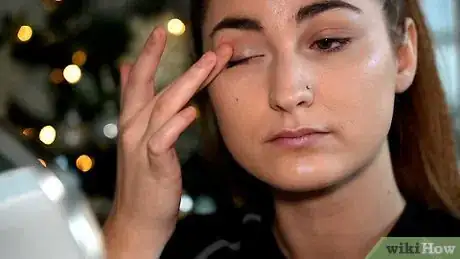
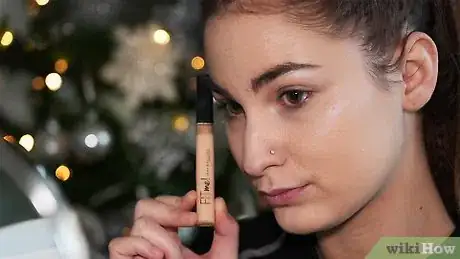
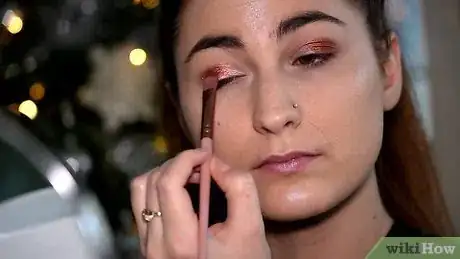

-Step-16-Version-5.webp)
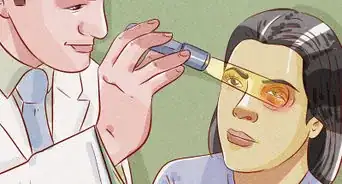

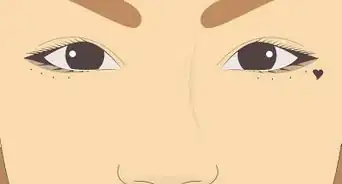


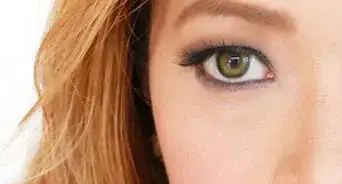






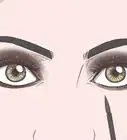
-Step-16-Version-5.webp)
